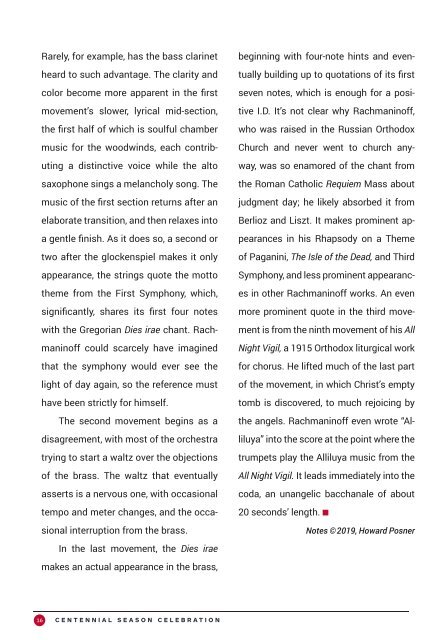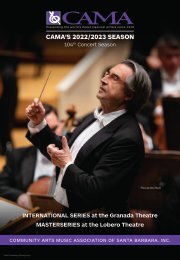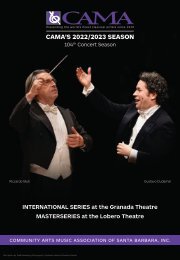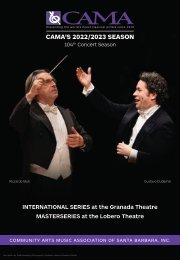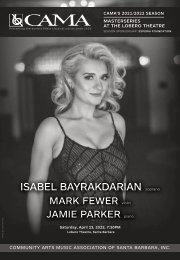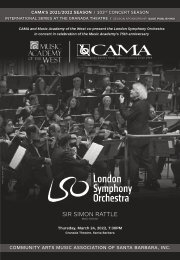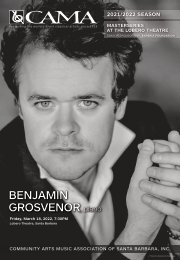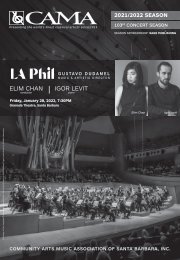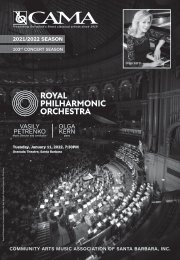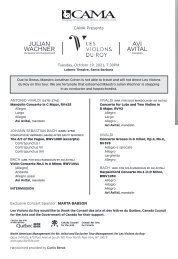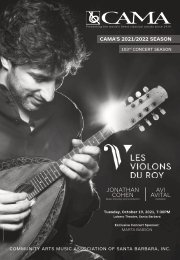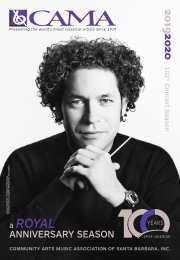Russian National Orchestra—February 27, 2019—CAMA's International Series at The Granada Theatre, Santa Barbara
WEDNESDAY, FEBRUARY 27, 2019, 8:00 PM Russian National Orchestra Mikhail Pletnev, conductor George Li, piano The Russian National Orchestra was founded by Mikhail Pletnev in 1990 as a courageous demonstration of artistic freedom during the Soviet regime and has risen to the pinnacle of the classical music world; it was selected recently as one of the world’s top orchestras by a panel of international critics. The RNO will perform a special all-Rachmaninoff program celebrating the 100th Anniversary of his arrival in America in 1918, when he took up permanent US residence for the rest of his life (and performed twice for CAMA at the Lobero in 1929 and 1941). The all-Rachmaninoff program will include his ever-popular Second Piano Concerto featuring Tchaikovsky Competition silver medalist George Li. ALL-RACHMANINOFF PROGRAM: Vocalise, Op.34, No.14 Piano Concerto No.2 in C Minor, Op.18 Symphonic Dances, Op.45 Tickets: https://ticketing.granadasb.org/single/SYOS.aspx?p=11750&promo=5032
WEDNESDAY, FEBRUARY 27, 2019, 8:00 PM
Russian National Orchestra
Mikhail Pletnev, conductor
George Li, piano
The Russian National Orchestra was founded by Mikhail Pletnev in 1990 as a courageous demonstration of artistic freedom during the Soviet regime and has risen to the pinnacle of the classical music world; it was selected recently as one of the world’s top orchestras by a panel of international critics. The RNO will perform a special all-Rachmaninoff program celebrating the 100th Anniversary of his arrival in America in 1918, when he took up permanent US residence for the rest of his life (and performed twice for CAMA at the Lobero in 1929 and 1941). The all-Rachmaninoff program will include his ever-popular Second Piano Concerto featuring Tchaikovsky Competition silver medalist George Li.
ALL-RACHMANINOFF PROGRAM:
Vocalise, Op.34, No.14
Piano Concerto No.2 in C Minor, Op.18
Symphonic Dances, Op.45
Tickets: https://ticketing.granadasb.org/single/SYOS.aspx?p=11750&promo=5032
Create successful ePaper yourself
Turn your PDF publications into a flip-book with our unique Google optimized e-Paper software.
Rarely, for example, has the bass clarinet<br />
heard to such advantage. <strong>The</strong> clarity and<br />
color become more apparent in the first<br />
movement’s slower, lyrical mid-section,<br />
the first half of which is soulful chamber<br />
music for the woodwinds, each contributing<br />
a distinctive voice while the alto<br />
saxophone sings a melancholy song. <strong>The</strong><br />
music of the first section returns after an<br />
elabor<strong>at</strong>e transition, and then relaxes into<br />
a gentle finish. As it does so, a second or<br />
two after the glockenspiel makes it only<br />
appearance, the strings quote the motto<br />
theme from the First Symphony, which,<br />
significantly, shares its first four notes<br />
with the Gregorian Dies irae chant. Rachmaninoff<br />
could scarcely have imagined<br />
th<strong>at</strong> the symphony would ever see the<br />
light of day again, so the reference must<br />
have been strictly for himself.<br />
<strong>The</strong> second movement begins as a<br />
disagreement, with most of the orchestra<br />
trying to start a waltz over the objections<br />
of the brass. <strong>The</strong> waltz th<strong>at</strong> eventually<br />
asserts is a nervous one, with occasional<br />
tempo and meter changes, and the occasional<br />
interruption from the brass.<br />
In the last movement, the Dies irae<br />
makes an actual appearance in the brass,<br />
beginning with four-note hints and eventually<br />
building up to quot<strong>at</strong>ions of its first<br />
seven notes, which is enough for a positive<br />
I.D. It’s not clear why Rachmaninoff,<br />
who was raised in the <strong>Russian</strong> Orthodox<br />
Church and never went to church anyway,<br />
was so enamored of the chant from<br />
the Roman C<strong>at</strong>holic Requiem Mass about<br />
judgment day; he likely absorbed it from<br />
Berlioz and Liszt. It makes prominent appearances<br />
in his Rhapsody on a <strong>The</strong>me<br />
of Paganini, <strong>The</strong> Isle of the Dead, and Third<br />
Symphony, and less prominent appearances<br />
in other Rachmaninoff works. An even<br />
more prominent quote in the third movement<br />
is from the ninth movement of his All<br />
Night Vigil, a 1915 Orthodox liturgical work<br />
for chorus. He lifted much of the last part<br />
of the movement, in which Christ’s empty<br />
tomb is discovered, to much rejoicing by<br />
the angels. Rachmaninoff even wrote “Alliluya”<br />
into the score <strong>at</strong> the point where the<br />
trumpets play the Alliluya music from the<br />
All Night Vigil. It leads immedi<strong>at</strong>ely into the<br />
coda, an unangelic bacchanale of about<br />
20 seconds’ length. n<br />
Notes © 2019, Howard Posner<br />
16 CENTENNIAL SEASON CELEBRATION


